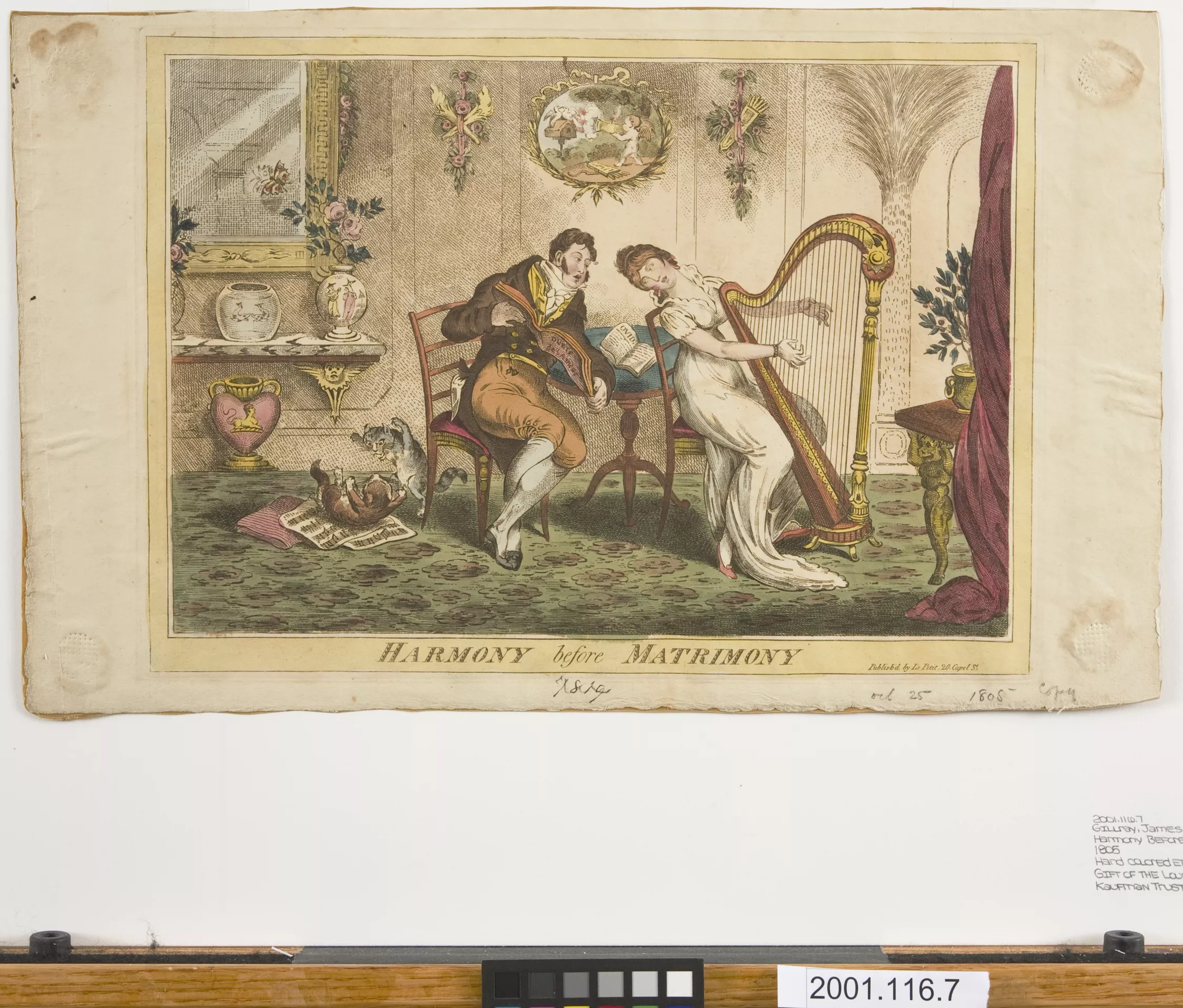Exhibit
Creation Date
1805
Height
25 cm
Width
35 cm
Medium
Genre
Description
This image depicts courtship as typically conceived by the Romantic imagination, as a moment of finding or establishing figurative harmony; such a moment or situation was dependent on the prior, elegant education of young ladies in certain, socially-mediating arts. However, the image works beyond this trope to subvert it, ultimately suggesting that the trope of "harmony" and the subjection of both women and romance to pretty but insubstantial configurations is eventually harmful.
In this etching, a young woman and man who are courting make music together. The woman plays a harp and leans over to read the music from the music book that the young man is holding. They both appear to be singing, and though the items featured in the background seem to indicate love—such as the heart-shaped vase and the shapely naiad holding up the nearby table—several disturbing images also appear. Two cats fight over a pile of sheet music in the corner, a book of Ovid’s work appears open on the table behind the lovers, and, in the cameo on the back wall, Cupid aims a gun rather than a bow and arrow at some birds.
James Gillray was a famous and widely distributed caricaturist during the eighteenth century. However, the etching’s content is more significant in terms of Romantic culture and aesthetics. Critics have noted that this piece and its companion piece, "Matrimonial—Harmonics," seem to be commenting on the genteel training in music, the Romance languages, and drawing that young women received, rendering them hilariously unfit for marriage. Gillray, however, is making an astute observation about music as well.
The title of this piece plays on the idea of harmony. A text from this time notes that “Harmony in music is the confluence of sweet sounds—music in parts (compound melody)” ("Harmonics"). As opposed to melody, which is a single line, harmony requires two or more voices working together to achieve sweetness. In this first etching, we see the man and woman doing just that—they harmonize, and the effect seems to be pleasant. The Romantics were very confident of the power of harmony in the social sphere. In addition to having musical resonance, harmony also had a social significance. As Leslie Ritchie notes, “musical harmony” was seen as producing “social harmony” (1). In the context of this etching, we can see these effects as they are focalized in the figure of the young woman. Ritchie argues that in order to understand the dual social and musical function of harmony, it is essential to restore the performer, as opposed to the composer, to the center of musical practices. In doing so, we gain a better understanding of the way that music functioned in the domestic and private spheres, where women such as the one in this print used music as a means of social expression and connection. Here, music becomes a mediating force in the courtship phase preceding marriage.
However, darker elements in the piece indicate domestic trouble in the future. Ovid is not a text for a respectable young lady to be reading, and the fighting cats, as well as the murderous Cupid, indicate that all is not easy beyond the halcyon days of courtship. "Matrimonial—Harmonics" carries these ominous rumblings through to their conclusion by depicting a husband and wife several years after marriage as thoroughly isolated from one another; music again becomes the conduit to express their states of mind. The title draws on the idea of harmonics, as opposed to harmony. Harmonics was “the science of the relations of sound, silence, and note, which science is otherwise called Music, Acoustics, or Phonics” ("Harmonics"). This scientific, empirical way of looking at music aligns itself with the prose of marriage, which poses a harsh contrast to the poetry of courtship. As opposed to harmony, which is fluid, natural, and lovely, harmonics is difficult and requires hard work and study. In Gillray’s companion piece, this work is not achieved, as the woman neglects her baby to the nursemaid, the animals go unfed, the kettle untended, and the husband retreats to the other side of the room, unwilling to engage in the relationship at all.
With this contrast, Gillray pokes fun at the tendency of the Romantic imagination to revel in harmony without a thought for harmonics. While musical harmony was thought to assist in social harmony, real consideration had to be given to things that could not be encompassed by music. The hard work of harmonics represents social criticism—what were the structures keeping this musical/social alignment in place, and what were the dangers inherent to this alignment? If no attention is given to the individual who is in fact performing the socially cohesive act of music, Gillray seems to be saying, there can be no future harmony. By offering this almost feminist critique of the unexamined reliance on this trope, Gillray asks the Romantic imagination to look more closely at what link, if any, could exist between the public and private spheres for women who were continually kept uneducated and taught fanciful instead of substantial subjects.
Locations Description
Gillray completed the caricatures at his lodgings with his publisher on St. James’s Street.
Accession Number
2001.116.7
Additional Information
Bibliography
"Harmonics, or the Analogy of Musical Sound." Musical World 12.85 (1839): 238-244. Print.
Feaver, William. Masters of Caricature: From Hogarth and Gillray to Scarge and Levine. New York: Knopf, 1981. Print.
Ritchie, Leslie. Women Writing Music in Late Eighteenth Century England. Aldershot: Ashgate, 2008. Print. Performance in the Long Eighteenth Century: Studies in Theatre, Music, and Dance.

